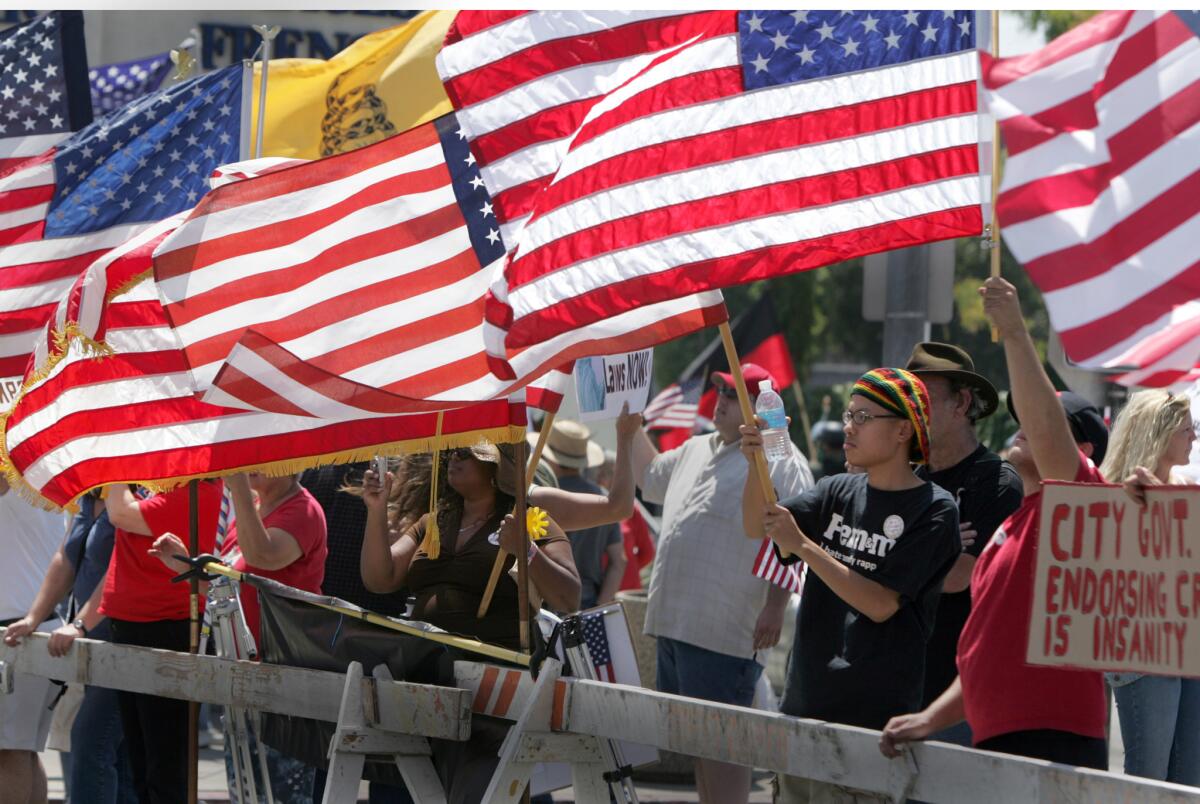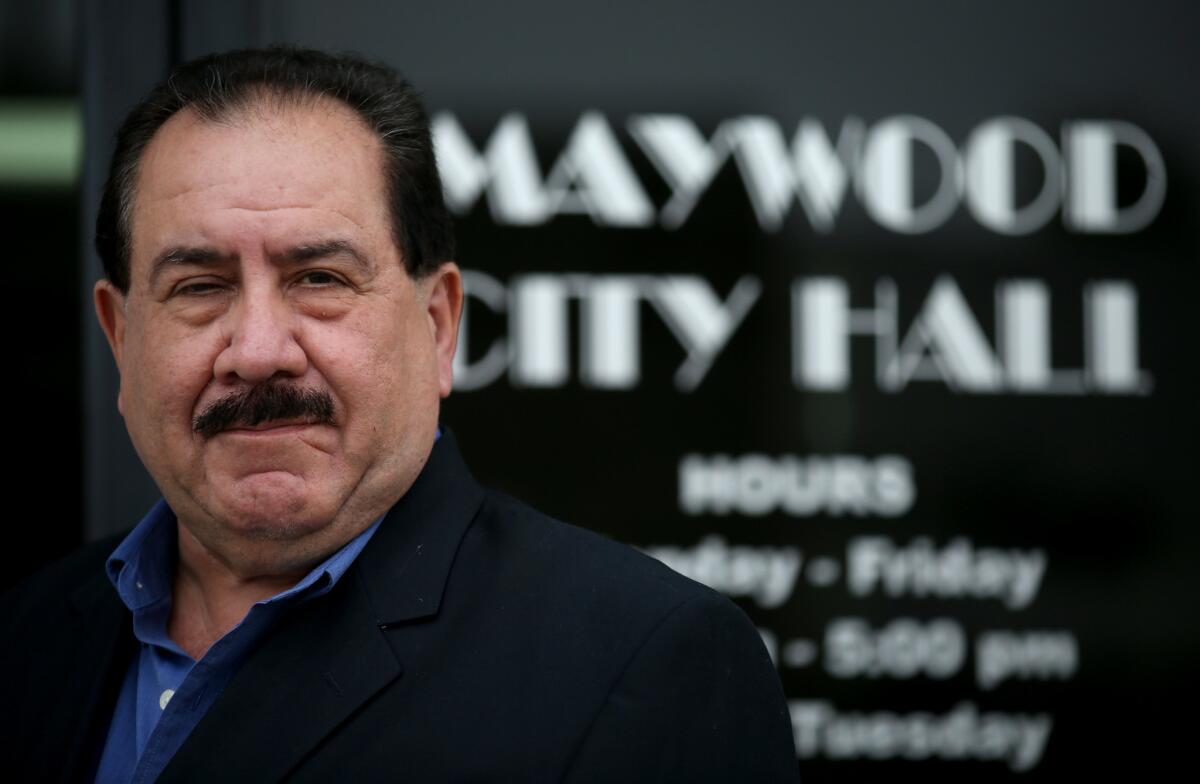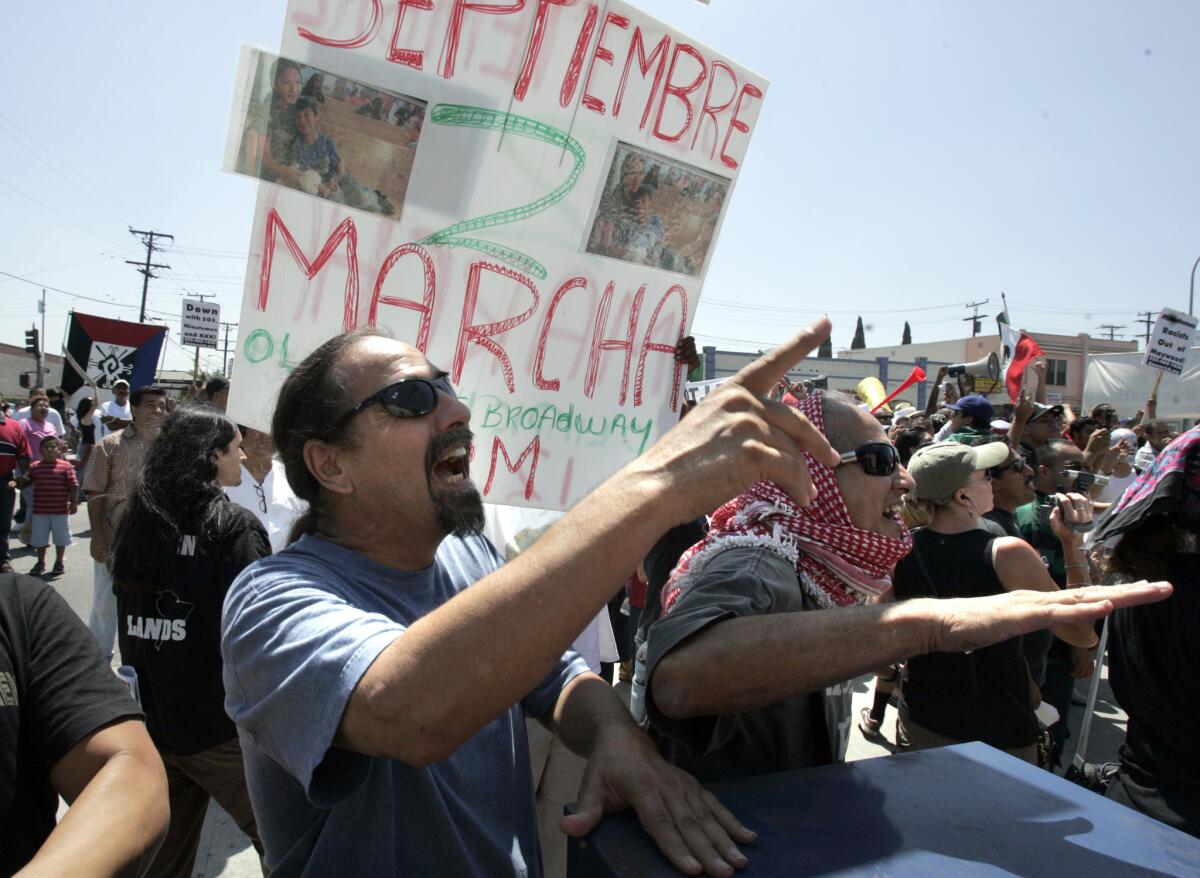This tiny California town’s battle over ‘sanctuary city’ status started long before Trump

- Share via
Maywood’s decision to declare itself a sanctuary city did not sit well with Enrique Curiel.
To the Mexican immigrant and U.S citizen, the move 11 years ago was City Hall acting too radical to score points with Maywood’s large immigrant population.
Becoming a sanctuary city turned the small southeast Los Angeles County suburb into a national lightning rod.
Conservative talk-radio hosts lit into Maywood. Members of the Minutemen Project, an anti-illegal-immigration group that patrols the border, descended on the town, and City Hall was inundated with outraged messages from across the U.S.
More than a decade later, President Trump has vowed to crack down on immigrants in the country illegally and threatened to punish sanctuary cities by denying federal funds.
And that has caused Curiel, 62, to look at Maywood’s status as a sanctuary city in a different light.
“Let them give Trump a good fight,” Curiel said. “He’s screwing everything up but the main people he’s trying to screw … is our own people.”
Maywood is among an estimated 400 sanctuary cities and counties in the country. The city, which has a total operating budget of $13 million, receives about $1.1 million in federal funds for the current fiscal year.
In the debate over sanctuary cities, most of the attention has fallen on large cities, such as L.A. and New York, where city leaders have struck a defiant tone against Trump.
But few places know what it’s like to be in the eye of the storm like tiny Maywood, which became a sanctuary city at a time when it was unusual to do so.
In 2006, Maywood was 96% Latino. Officially the city had just under 30,000 residents. About 45% of the city’s residents are foreign born.
Maywood’s decision years ago to become a sanctuary city infuriated some residents. Many of the critics were older white residents and more conservative Latinos.
“I disagree with sanctuary cities because it breaks federal law,” said Sandra Orozco, a longtime Maywood resident and activist. “I don’t like that it’s interfering with the federal funding.”
At that time, many states and cities were trying to crack down on illegal immigration.
In Washington, the House of Representatives tried to get a law passed that made it a crime to assist immigrants illegally living in the country. Massive protests broke out across the U.S., including one in Los Angeles that drew more than 500,000 people.
But Maywood officials were determined to buck that trend. And one spark was police checkpoints in the city of 1.2 square miles.
The roadblocks, which started in the 1990s, led to vehicles being impounded for up to 30 days. At times, the storage fees were so high that some drivers forfeited their cars.
The checkpoints were often held during rush hour and created traffic jams that stretched into neighboring cities. The owner of Maywood Club Tow even provided free catering trucks for officers.
The checkpoints generated hundreds of thousands of dollars for the towing company and the city.
David Velazquez, then a priest at St. Rose of Lima Roman Catholic Church, said he was overwhelmed with complaints about the checkpoints, which seemed more aimed at catching unlicensed immigrant drivers.
“Some people didn’t have the money; they lost their jobs, their homes and the kids couldn’t go to school. It was really a disaster,” Velazquez said. Police “claimed they were looking for drunk drivers but it was really an excuse to persecute immigrants.”

Velazquez found an ally in Felipe Aguirre, who ran an immigrant advocacy and counseling group before becoming a councilman.
Aguirre said he began helping people fight the tickets. Eventually, Aguirre joined the priest and began showing up at City Hall to complain about the checkpoints.
When that didn’t work, Aguirre ran for office in 2005 with two other candidates and won.
Aguirre and his allies replaced a relatively conservative Latino majority with a more activist one.
The new leadership got rid of the checkpoints and dismantled the city’s traffic department.
The actions were polarizing. Residents angrily argued in Spanish and English during raucous council meetings.
“At every meeting in the city, there were fights,” Velazquez recalled. “It was terrible.”
The next fight was even nastier.
Velazquez said he had heard about towns that had become sanctuary cities. The word “sanctuary” reminded him of the 1980s when churches offered immigrants protection from raids.
Aguirre said he spoke to Velazquez about the idea and in January 2006, the city council unanimously passed a resolution to declare itself a sanctuary city.
Sam Peña, then a councilman who frequently butted heads with the Aguirre-led majority, was accused of being “anti-immigrant” for opposing some of the moves. He pointed out that his own parents were Mexican immigrants.
But even Peña said he didn’t anticipate the reaction to the sanctuary city decision.

He said officials had to explain to residents what it meant to be a sanctuary city.
“I think people just wanted clarity, and it basically was that the police department was there not to act as immigration agents,” Peña said. “People were still going to have to abide by traffic laws, and any kind of disputes, the police was going to get involved.”
For months the city was mired in heated protests involving white supremacists, Minutemen Project members and anti-immigration groups.
But Peña added: “Even though we were in the middle of the hurricane while everything was going on — white supremacists coming in, we were getting threats, we were getting the national spotlight — you look back at it now … and it helped our community.”
Today, Maywood is still a politically tumultuous city. But Peña said it’s hard to imagine now fights breaking out in the council chambers over the sanctuary city issue.
“Now, when people say it’s a sanctuary city, it’s almost a foregone conclusion,” Peña said.
On a recent afternoon, Jesus Leal played with his two granddaughters in front of his small, single-story home.
Leal, who entered the U.S. illegally but became a legal resident in the 1980s, arrived in Maywood when it was still predominately a white community. In the 1970s, when manufacturing jobs began disappearing, the city saw an influx of Latino immigrants.
Leal remembers how difficult it was to find work. He was paid $1 an hour at a car wash and had to go outside the city to find tortillas.
He said he’s glad Maywood and other cities are sticking up for immigrants who lack legal status.
“I think about this and I just know what they’re going through,” he said. “So I’m in support of our town.”
For more Southern California news, follow @latvives on Twitter.
Times staff writer Sandra Poindexter contributed to this report.
ALSO
San Francisco sues Trump over executive order targeting sanctuary cities
BART rail system may designate itself a ‘sanctuary in transit’
Santa Ana declares itself a sanctuary city in defiance of Trump
More to Read
Sign up for Essential California
The most important California stories and recommendations in your inbox every morning.
You may occasionally receive promotional content from the Los Angeles Times.











